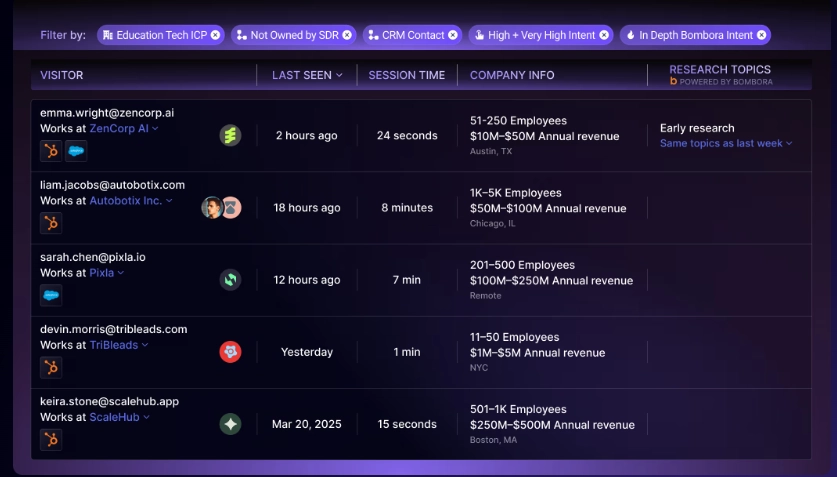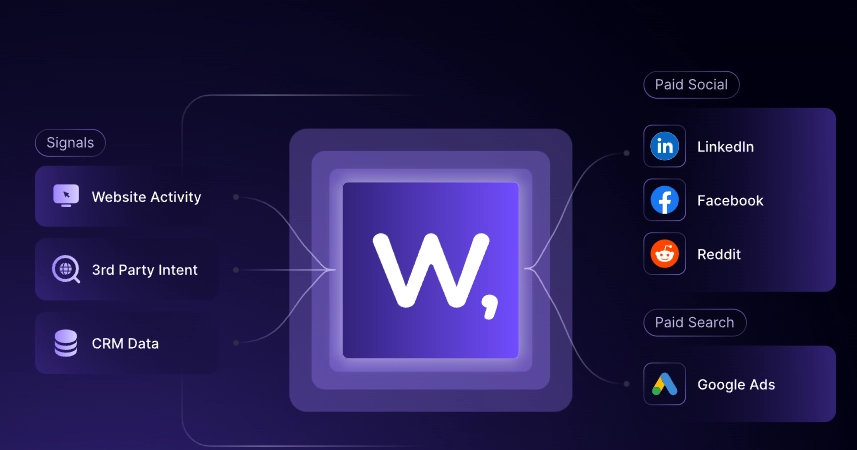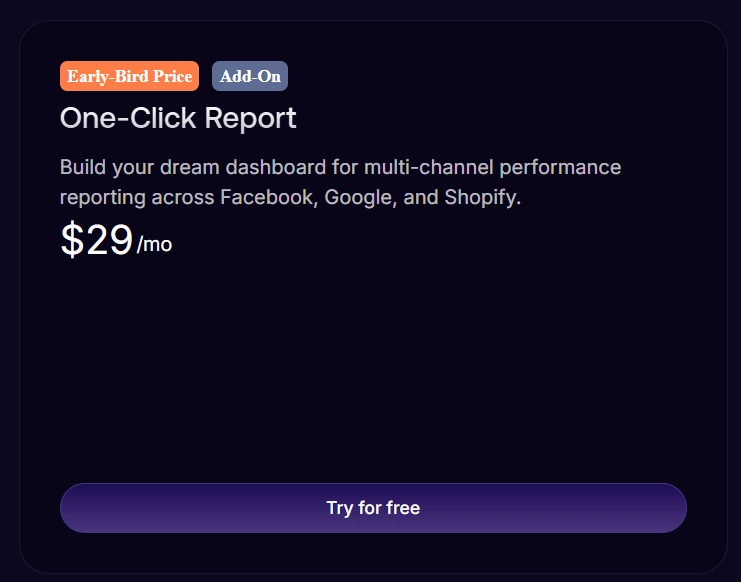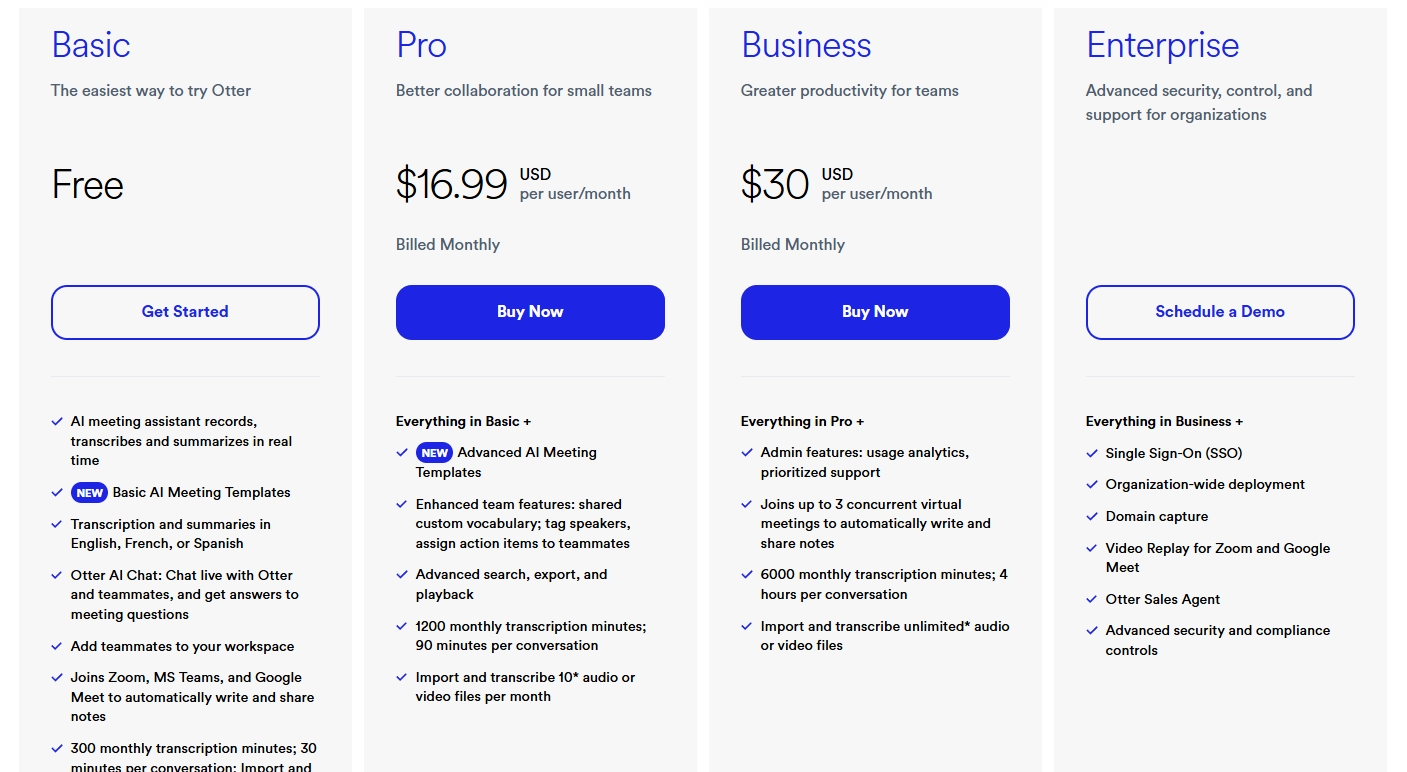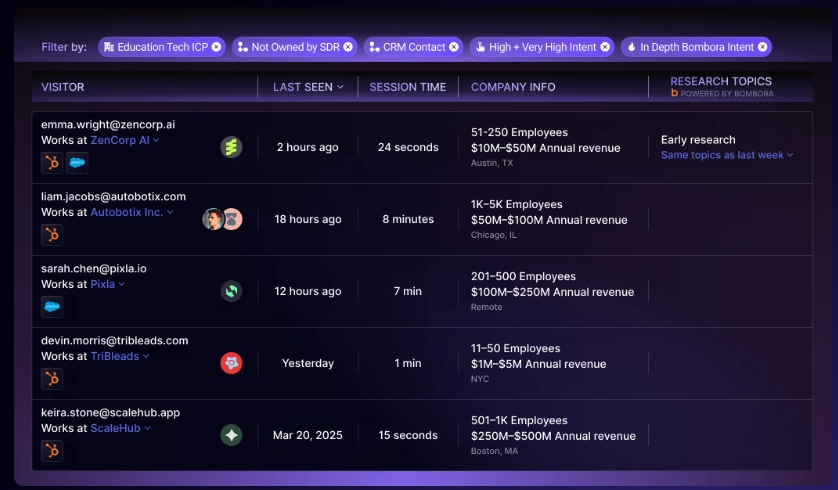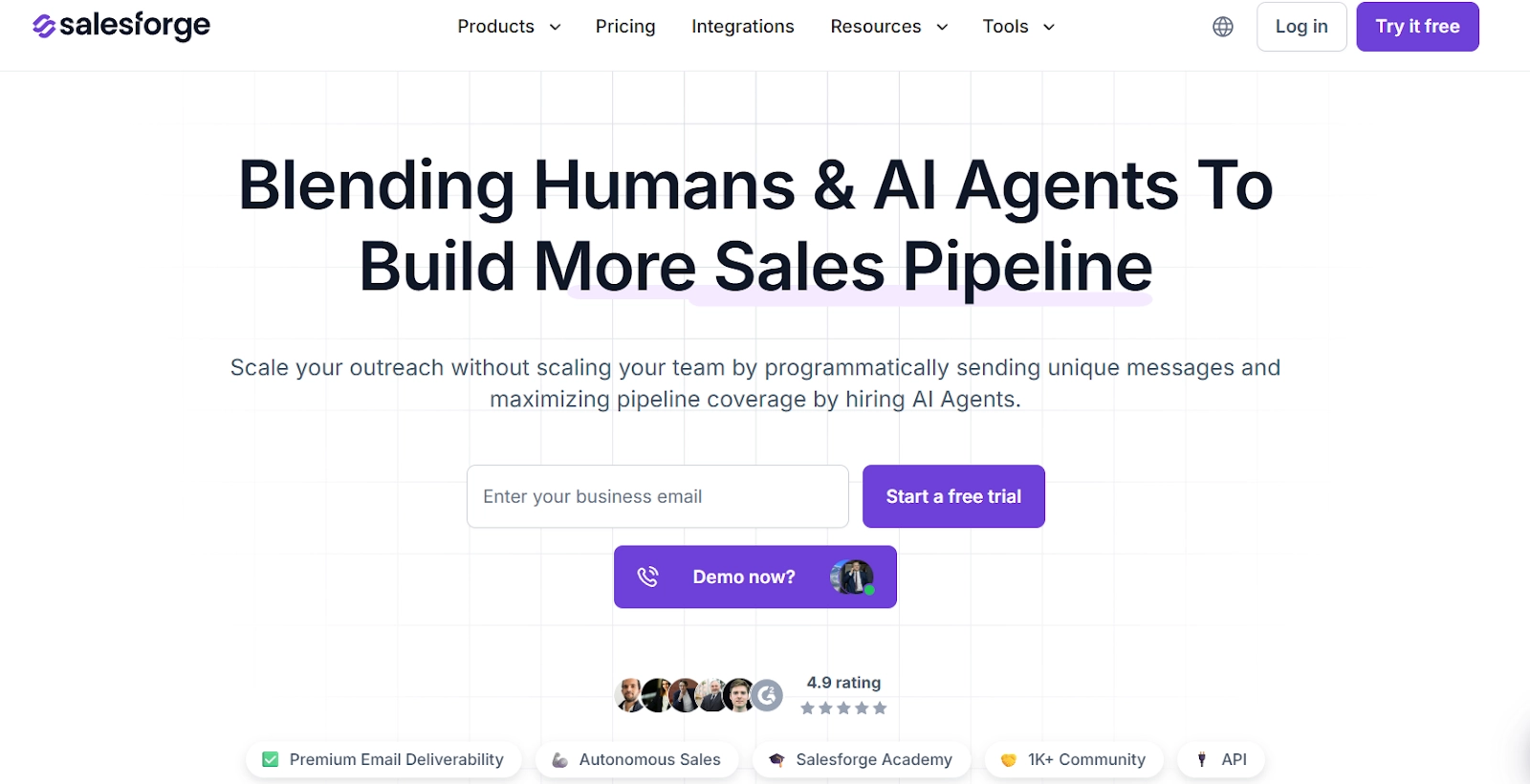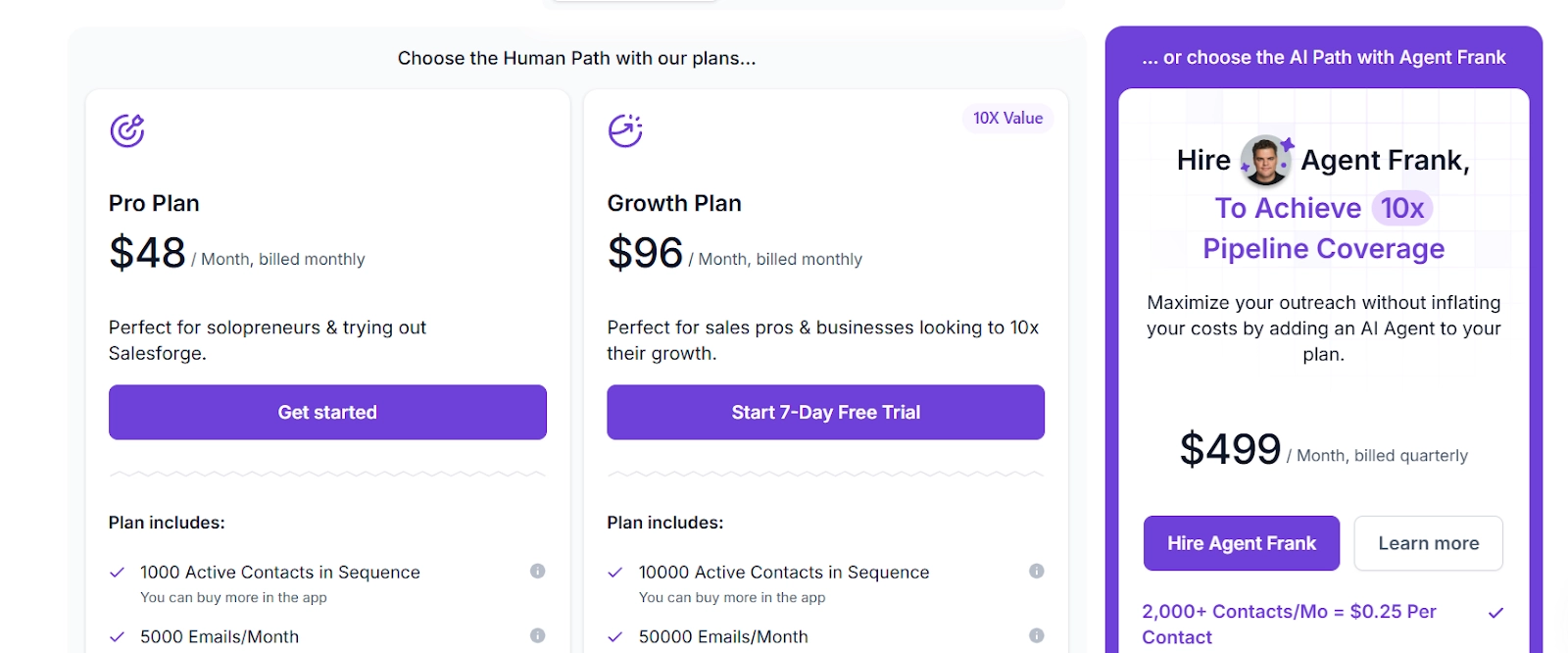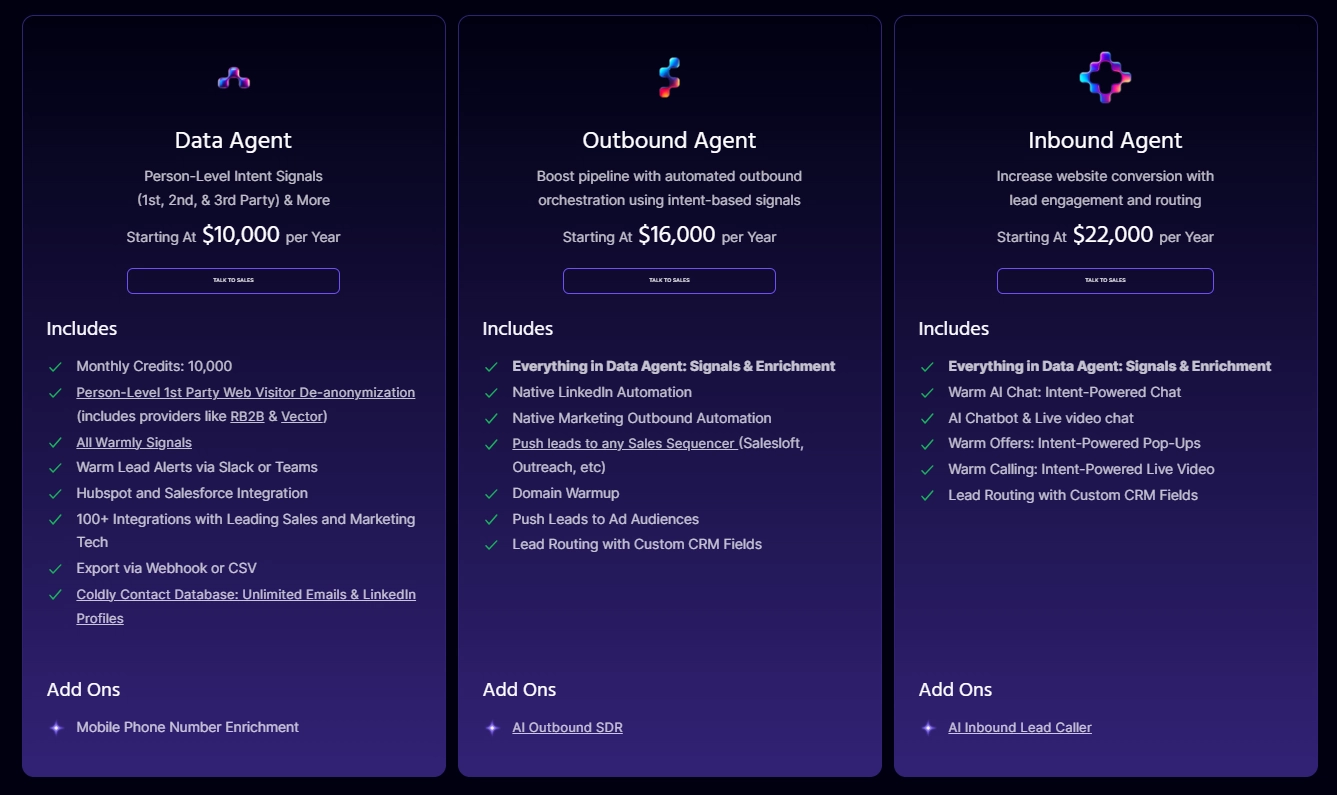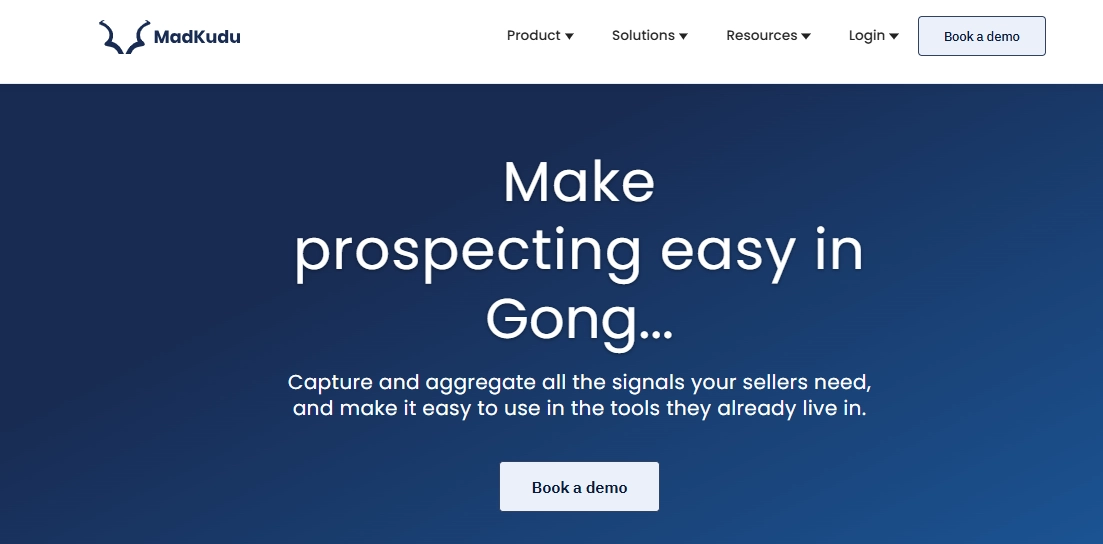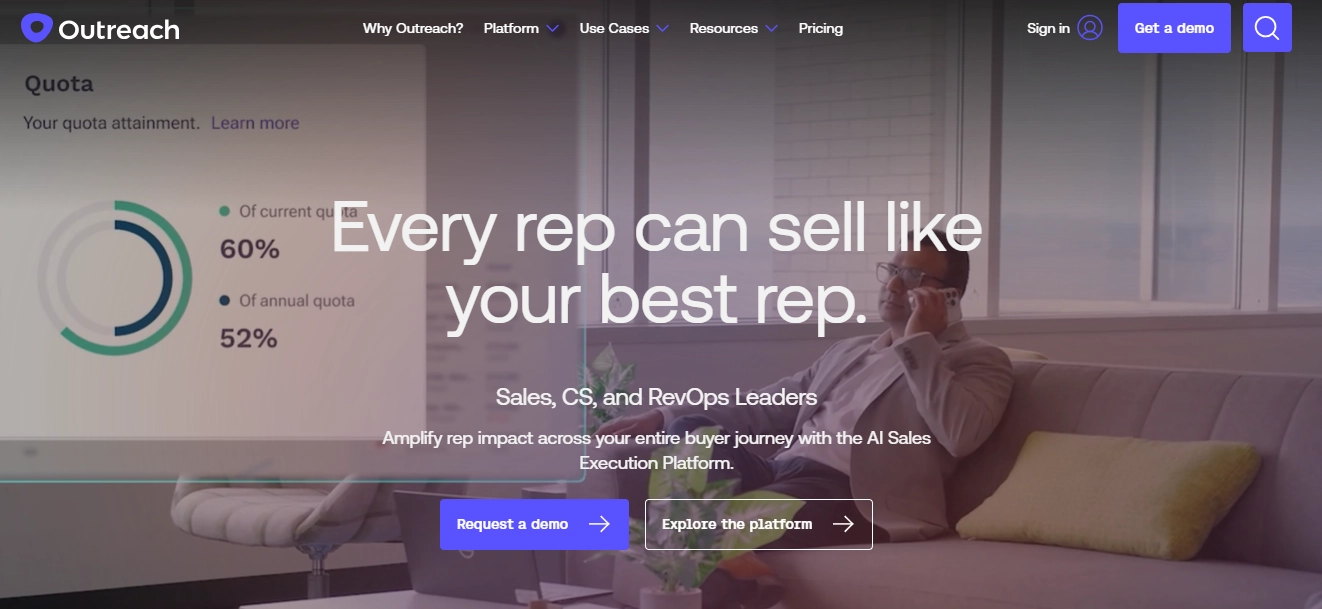
AI Data Enrichment: What Is It & How To Do It [September 2025]
In 2025, sales teams don’t win with more data. They win with smarter data.
That’s where AI data enrichment comes in.
Instead of relying on static lists or partial profiles, enrichment tools powered by AI can automatically fill in the blanks, validate details, and surface critical insights, all in real-time.
Whether it’s identifying decision-makers, uncovering buying signals, or syncing firmographic data across your stack, enriched data means your team spends less time guessing and more time closing.
In this article, I’ll break down what AI data enrichment really is, how it works, why it matters for modern GTM teams, and how to implement it right, plus the top tools to consider as a bonus.
Let’s dive into the tech that turns raw contacts into ready-to-convert leads!
What is AI data enrichment, and how does it work?
AI data enrichment is the process of enhancing raw or incomplete data by automatically adding relevant, real-time information using artificial intelligence.
Instead of relying on manual research or third-party lists that go stale quickly, AI enrichment tools connect to multiple data sources (like public databases, proprietary datasets, CRM records, and third-party APIs) to fill in the blanks accurately and at scale.

Here’s how it typically works:
- AI models ingest your existing records, such as lead lists, contact info, or firmographic data.
- They cross-reference these entries against real-time sources to verify, supplement, or correct missing information (like job titles, buying signals, industry, tech stack, recent funding, etc.).
- Machine learning ensures the enrichment becomes smarter over time, prioritizing high-confidence matches and eliminating duplicates or bad data automatically.
The result?
A living, breathing database that’s always up-to-date and immediately actionable without hours of manual effort.
And because the enrichment happens automatically, your sales and marketing teams stay focused on engaging the right people, not cleaning up endless rows of spreadsheets.
Next, let’s look at why this matters and how AI takes enrichment to the next level.
What are the benefits of using AI for data enrichment?
The main benefits of using AI for data enrichment include real-time precision and freshness, hyper-targeted segmentation and personalization, and the fact that you'll save time from manually researching prospects.
AI data enrichment isn’t just about speed.
It’s about turning scattered, outdated, or incomplete data into revenue-ready sales intelligence that helps GTM teams move faster, personalize smarter, and close more deals.
Here's what that unlocks:

1. Real-time precision and data freshness
AI enrichment tools continuously sync your data with live external sources, pulling in updates on titles, funding rounds, tech stack changes, and more.
This means your team is always working with the most accurate and up-to-date information available, not lists that went stale three months ago.
2. Hyper-targeted segmentation and personalization
With richer data, such as technographics, job roles, or recent buying intent, you can segment leads far more effectively and personalize your messaging at scale.
AI makes it possible to go beyond surface-level traits and speak to what actually matters to each account or buyer.
3. Automation that reduces manual effort
Traditionally, enrichment meant hours of spreadsheet work or chasing leads on LinkedIn.
With AI, that legwork is automated.
New leads are enriched as they enter your system, and existing records are continuously updated, freeing up time for reps to focus on outreach and deal progression.
4. Better conversions across the funnel
When you’re reaching out to the right people, with relevant context, at the right moment, responses naturally go up.
AI-enriched data directly impacts conversion rates by powering smarter targeting and reducing the guesswork in your GTM motion.
5. Improved CRM hygiene and data confidence
Bad data costs you, resulting in lost deals, wasted outreach, and reporting errors.
AI helps keep your systems clean by deduplicating records, flagging inconsistencies, and enriching missing fields in real-time.
This means there’s no more bloated CRMs full of half-complete or outdated profiles.
6. Competitive edge at every touchpoint
Teams that adopt AI enrichment don’t just move faster - they move smarter.
With richer signals and deeper context behind every lead, your GTM strategy becomes more predictive, more personalized, and ultimately more effective than those still relying on static, manual data.
What are the different types of data enrichment?
There are several different kinds of data enrichment, each serving a distinct purpose and playing its role in your marketing strategy.
Here are the key types you’ll see, which are often combined in modern enrichment platforms:
- Firmographic enrichment - Adds business-level data like industry, company size, revenue, location, and growth stage. This is essential for B2B segmentation and ideal customer profiling.
- Technographic enrichment - Surfaces what tools or platforms a company is using, like CRM, cloud infrastructure, ad tech, or sales software. This is useful for competitive targeting, integrations, and outbound personalization.
- Demographic enrichment - Fills in individual-level details like job title, seniority, department, and social profiles, so you’re not just targeting “a company,” but the right person inside it.
- Behavioral and intent enrichment - Brings in real-time buying signals, such as recent site visits, content downloads, hiring trends, or spikes in keyword research. This is where AI really shines, surfacing leads that are actually in-market.
- Contact enrichment - Adds missing details like email addresses, phone numbers, or LinkedIn profiles for outreach-ready records, often with confidence scoring and automatic syncing to your CRM or sales tools.

Together, these enrichment types give you a 360-degree view of who your leads are, what they’re doing, and how best to engage them without chasing static lists or scraping the internet manually.
What are the different AI data enrichment techniques?
AI data enrichment is not just about appending missing fields.
It's about transforming raw data into actionable intelligence through a variety of sophisticated techniques.
Here's a quick overview of the most impactful methods:

1. External data integration
This technique means adding useful information to your existing customer or lead data by pulling data from outside sources.
For example, AI can look at public records, social media, company websites, or quickly sift through databases like Coldly to find extra details, like someone’s job title, the size of their company, or what tools they use.
By combining this external data with what you already have, you get a more complete picture of who your buyers are and how to reach them more effectively.
2. Data cleansing and deduplication
This technique helps clean up messy or incorrect data in your CRM or other lead databases.
AI looks for things like typos, missing fields, outdated info, or records that show up more than once.
For example, if the same lead is entered twice in your CRM with slightly different names or email addresses, AI can spot it and fix it automatically.
As a result, you get clean, accurate, and reliable data that your team can actually trust.
3. Semantic enrichment
This technique is all about giving your data more meaning.
AI looks at what’s already in your database and connects it to related topics or categories using public knowledge sources.
For example, if a contact’s job title is “VP of Growth,” semantic enrichment might also tag them as part of the marketing department or leadership team.
This helps your team understand context and improves targeting, allowing you to spot key stakeholders and related accounts more easily.
4. Geospatial enrichment
This technique adds location data, like the exact coordinates or region a person or company is based in.
So instead of just knowing someone is in “New York,” AI might add their zip code or nearby landmarks.
This is especially useful for planning local mail campaigns, assigning territories, or optimizing deliveries.
5. Sentiment analysis
AI reads through text like social media posts, reviews, or survey answers, and figures out the tone.
Is someone happy, frustrated, or excited?
Sentiment analysis helps companies understand how people feel about their brand, product, or service without having to read through every single comment.
6. Multimedia content analysis
Multimedia content analysis helps you understand and organize large volumes of visual content, such as images and videos, without manual review.
AI can scan a photo or video and figure out what’s in it, such as objects, people, logos, or even emotions.
It also pulls out useful details (like location tags or timestamps), helping companies organize and understand their visual content more easily.
This way, if your brand is mentioned in a product unboxing video or someone posts a photo with your logo, AI can detect that automatically.
It’s essential for brand monitoring, content moderation, and making smarter use of user-generated content.
7. Predictive analytics
AI looks at past behavior and trends to guess what might happen next.
For example, if a lead has visited your pricing page three times and opened your last two emails, predictive analytics might flag them as likely to buy soon.
This helps you prioritize outreach and take action at the right time.
8. Behavioral data enrichment
This technique tracks how people interact with your website, emails, or product, and then adds those insights to their profile.
This includes things like: which pages they visited, how long they stayed, and what they clicked on.
It gives you a clearer view of what someone is interested in right now, so you can follow up in a smarter, more relevant way.
Platforms like Warmly excel in this, leveraging sophisticated AI models to screen for and identify intent signals in real-time, combining internal data (interactions with your website) with external data from 10+ data enrichment providers.

As a result, you can:
- Identify high-intent leads while their interest is at its peak.
- Create detailed lead segments and target audiences.
- Craft hyper-personalized outreach strategies leveraging the data you have on each lead.
How can you incorporate AI data enrichment into your sales process?
When it comes to incorporating AI data enrichment, the good news is that you don’t need to reinvent your sales process to benefit from it.
You just need to plug it into the right places.
Here’s how to make it work, step by step:
Step #1: Start with your CRM or lead source
Before you do anything else, connect your AI data enrichment tool to wherever your leads first enter the system, which is usually your CRM (like HubSpot, Salesforce, or Pipedrive) or your lead capture forms (like website forms, demo requests, or webinar signups).
Once connected, the AI can automatically enrich each new contact as they come in, adding details like job title, company size, LinkedIn profile, industry, and more.
Say someone fills out your demo request form and only gives you their name and work email.
Without enrichment, your team has very little to go on.
But with AI data enrichment connected to your CRM:
- The system identifies that the person is Julia Wong, Head of Product at a Series B fintech company using Salesforce and Stripe.
- It automatically adds her LinkedIn profile, company headcount, funding stage, and a few recent company updates.
As a result, your rep now knows who she is, what her company does, and can tailor the pitch accordingly.
Step #2: Clean and enrich existing records
Your CRM might already be packed with leads, but if that data is old, incomplete, or duplicated, it’s holding your team back.
This step is about using AI to automatically:
- Fill in missing fields (like job titles or industries).
- Update stale info (like a contact who changed roles or companies).
- Merge duplicates so you’re not contacting the same person twice.
It’s the fastest way to turn your database into a useful, up-to-date sales asset.
For example, imagine your rep is about to follow up with Sophie D., but her CRM record hasn’t been touched in over a year.
With AI enrichment:
- You discover she’s no longer at her old company - she’s now VP of Marketing at a startup that just raised a Series A.
- The AI updates her profile, syncs her new LinkedIn, and tags her new company with relevant firmographics.
Now your rep knows Sophie’s a high-value target and not a dead-end lead.
Step #3: Use enriched data to segment smarter
Once your data is enriched, you can go far beyond basic filtering.
Instead of blasting generic messages to everyone in your CRM, AI-enriched fields let you create precise, dynamic segments based on:
- Company size.
- Industry.
- Funding stage.
- Tech stack.
- Buying signals.
- Job seniority, and more.
For instance, Warmly’s Marketing Ops agents work 24/7 on building targeted audience segments, unearthing granular insights and traits that go beyond just firmographics.

This way, you get more accurate, always updated ICP and dynamic, well-targeted audiences.
The outcome?
Smarter segments = more relevant messaging = better results.
Step #4: Prioritize leads based on real signals
Not all leads are created equal, and AI enrichment helps you spot the ones most likely to convert.
By layering in signals like job changes, recent funding, hiring spikes, or product research behavior, AI can help you automatically score and prioritize leads based on who’s showing real buying intent.
This means your reps stop wasting time on cold or low-fit prospects and focus on the ones that are actually worth it.
For example, if you’ve got 300 leads sitting in your CRM, AI enrichment can highlight that:
- 5 of them work at companies that just raised a Series B,
- 2 have just installed a competitive tool your product integrates with,
- And 1 rep just switched into a new buying role last week.
And voila - that’s your shortlist! That’s who your team should talk to today.
Step #5: Personalize your outreach at scale
Enriched data turns generic outreach into relevant, high-converting messages without making your team write everything from scratch.
With details like job title, industry, tools used, recent activity, or even company news, your reps (or your AI assistant) can personalize emails, InMails, and call openers automatically.
You still get the scale, but now it feels like 1:1 communication.
This means that instead of sending:
“Hi Jamie, I’d love to connect and share what we’re building.”
You send:
“Hi Jamie, I saw you recently joined Acme as Head of GTM. Since you’re using HubSpot + Gong, I thought I’d share how we help RevOps teams using that same stack increase pipeline coverage.”
With tools like Warmly, you can put the entire outreach process on autopilot:
- The platform identifies high-intent leads and enriches them with in-depth B2B and intent data.
- Its AI SDR agents automatically pick up those leads and include them in email or LinkedIn sequences, using the info they have on each lead to tailor messaging accordingly.

The result?
Higher open, reply, and conversion rates across channels.
Step #6: Sync across your stack
It’s not enough to enrich your data. You need to make sure everyone in your GTM motion is seeing and using it.
That means syncing enriched profiles across your CRM, email tool, sales engagement platform, and analytics dashboards.
When done right, every system pulls from the same up-to-date, enriched source of truth and your reps, marketers, and ops folks stay aligned.
Step #7: Review and refine regularly
AI data enrichment isn’t a “set it and forget it” solution.
To get the best results, you’ll want to monitor performance, audit your data health, and adjust your enrichment strategy as your sales process evolves.
Look at which enriched fields actually help your team convert.
Is the funding stage more useful than the tech stack? Are job titles getting messy again?
Refining over time keeps your data - and your strategy - sharp.
For example, if you notice your reps rarely use the “industry” field but rely heavily on job seniority and recent hiring signals, that’s your cue to update your scoring model and prioritize the fields that actually drive results.
What are some of the challenges in using AI for data enrichment?
While AI data enrichment can certainly transform your sales process, like any powerful tool, it comes with its own set of challenges.
Let’s look at some of the most common issues teams face (and how to overcome them):

1. Data quality in, data quality out
AI can enrich your data, but it can’t work miracles if your starting point is garbage.
If your CRM is full of outdated, mislabelled, or inconsistent records, enrichment tools may struggle to match or append the right information.
💡Tip: Start with a basic data clean-up before layering in AI. The better your foundation, the better the enrichment results.
2. Integration complexity
Many enrichment tools promise plug-and-play, but syncing them across multiple platforms (CRM, sales engagement, analytics) can get messy, especially if your systems are siloed or custom-configured.
💡Tip: Choose tools with native integrations for your core stack, and work closely with RevOps or your CRM admin to set up clean, bi-directional syncs.
3. Over-enrichment or irrelevant fields
Just because you can add 30 new fields to every contact doesn’t mean you should.
Too much data clutters your workflows, confuses reps, and can even hurt personalization if the info isn’t actually helpful.
💡Tip: Be selective. Focus on enriching fields your team will use, such as job role, seniority, and buying signals, not vanity metrics.
4. Privacy and compliance risks
Pulling in external data, especially personal or behavioral data, can introduce privacy issues.
You’ll need to make sure you’re compliant with GDPR, CCPA, and other local regulations around data usage and transparency.
💡Tip: Use enrichment providers who are transparent about their data sources and have strong privacy practices in place. Always give users a way to opt out if required.
5. AI blind spots or mismatches
No system, including AI, is perfect.
Sometimes enrichment tools misidentify people, attach the wrong company data, or pull in outdated information.
If you rely too heavily on enrichment without validation, your reps may act on bad signals.
💡Tip: Set confidence thresholds for enriched fields. Some tools let you prioritize “high certainty” matches or even flag data for manual review before syncing to your CRM.
Next steps: Get smarter data to do sharper outreach with Warmly
In today’s sales landscape, it’s not about how much data you have.
It’s about how accurate, timely, and actionable that data is, and that’s where AI-powered enrichment makes all the difference.
By automating enrichment, syncing it across your tools, and embedding it into your workflows, you can unlock faster research, better segmentation, and truly personalized outreach at scale.
But the key isn’t just adding data - it’s knowing what to do with it.
Warmly helps GTM teams not only enrich leads with real-time firmographic and behavioral signals, but also act on them, automatically surfacing the hottest accounts, adapting outreach, and helping reps prioritize with confidence.
Want to see it in action? Book a demo with Warmly and discover how smarter data can fuel more efficient selling.
Read more
- The 12 Top Lead Enrichment Tools for GTM Teams in 2025 - Discover the best lead enrichment tools that modern GTM teams are using to turn raw contact data into revenue-ready insights.
- 9 Best Data Enrichment Tools in 2024 - Explore the top platforms helping B2B teams clean, complete, and supercharge their databases with smarter, more actionable data.
- AI Lead Scoring: What Is It & How To Do It Right In 2025? - Learn how AI is changing lead scoring forever and how to use it to prioritize the right prospects at the right time.
- AI for Sales Prospecting: How to Use It? [2025] - Find out how AI is helping sales teams prospect faster, better, and with less manual effort in 2025.
- AI GTM: Top Use Cases, Software, & Examples [2025] - See how AI is transforming every stage of the go-to-market motion with real-world tools and workflows that actually deliver.
- How to Evaluate B2B Data Providers: The Warmly Decision Framework - Use this proven framework to confidently choose the right data partner for your sales and marketing needs without the guesswork.
- How to Use AI in Your Sales and Marketing Tech Stack - Unlock practical tips for integrating AI into your GTM stack to boost performance, automation, and revenue impact.
- AI-Powered Sales Automation: Use Cases, Examples & Software - Explore how AI is automating everything from outreach to pipeline progression—and which tools are leading the way.




















